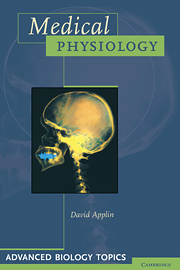Book contents
- Frontmatter
- Contents
- 1 What is disease?
- 2 Understanding the immune system
- 3 The control of bleeding
- 4 Heart disease
- 5 Physiological effects of exercise
- 6 Food and health
- 7 Diseases of the gaseous exchange system
- 8 Kidney failure
- 9 Fertility and contraception
- 10 The brain: memory, ageing and the effects of drugs
- 11 Medical genetics
- 12 Biotechnology and medicine
- Index
- Frontmatter
- Contents
- 1 What is disease?
- 2 Understanding the immune system
- 3 The control of bleeding
- 4 Heart disease
- 5 Physiological effects of exercise
- 6 Food and health
- 7 Diseases of the gaseous exchange system
- 8 Kidney failure
- 9 Fertility and contraception
- 10 The brain: memory, ageing and the effects of drugs
- 11 Medical genetics
- 12 Biotechnology and medicine
- Index
Summary
Our diet is the food we eat and drink. It is one of the most important environmental factors affecting health. However, links between diet and health problems are not always clear cut. It is often difficult to pin down cause and effect. Rather, different dietary factors are associated with particular diseases. For example, a high fat diet is associated with the development of heart disease (chapter 4). However, we are not sure that it causes heart disease, even though it seems highly likely that this is the case.
Basic principles
We need food because the body needs the nutrients and energy that food contains. Nutrients are substances necessary for health and growth. Table 6.1 lists the categories of nutrients and their functions in the body. Water is also essential and accounts for about two-thirds of body weight. It is a solvent in which the chemical reactions of metabolism take place and in which substances are transported around the body.
Notice that each category of nutrient performs one or more of three basic functions:
provides energy – carbohydrates and fats (proteins only when carbohydrates and fats are in short supply);
serves as components of body structures, and for growth and repair – proteins, minerals and water;
regulates metabolism – minerals and vitamins.
Gram for gram, the oxidation of protein releases more energy (22.2 kj per g) than carbohydrate (17.2 kj per g). […]
- Type
- Chapter
- Information
- Medical Physiology , pp. 57 - 71Publisher: Cambridge University PressPrint publication year: 1997



